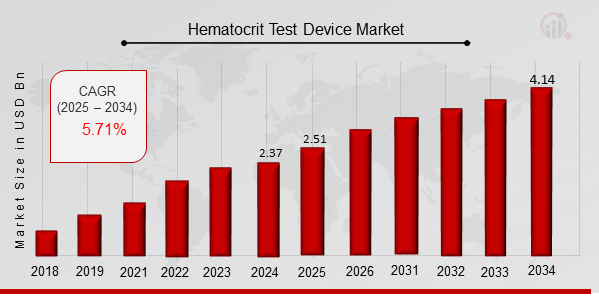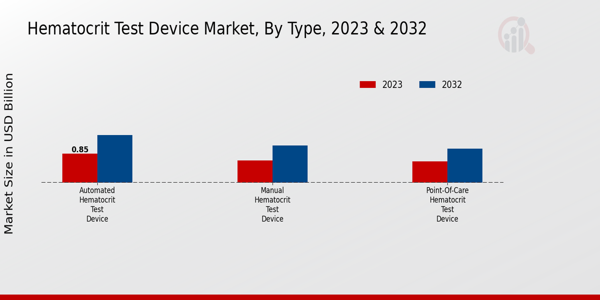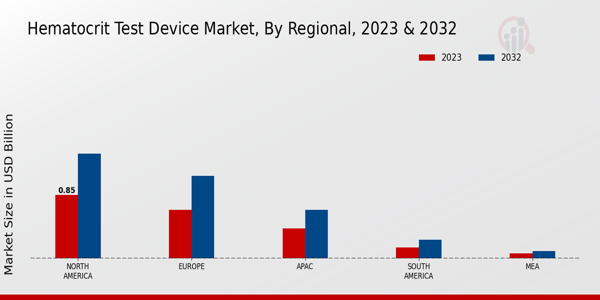Hematocrit Test Device Market Overview
As per MRFR analysis, the Hematocrit Test Device Market Size was estimated at 2.37 (USD Billion) in 2024. The Hematocrit Test Device Market Industry is expected to grow from 2.51 (USD Billion) in 2025 to 4.14 (USD Billion) till 2034, at a CAGR (growth rate) is expected to be around 5.71% during the forecast period (2025 - 2034).
Key Hematocrit Test Device Market Trends Highlighted
The Hematocrit Test Device Market is experiencing significant growth driven by the increasing prevalence of blood disorders and the rising demand for rapid diagnostic tests. An aging population and lifestyle changes contributing to health issues are further propelling the need for efficient hematocrit testing. Additionally, advancements in technology, such as the development of portable and user-friendly devices, are enhancing the accessibility and efficiency of testing. These drivers create a favorable environment for market expansion as healthcare providers seek reliable and quick analytical methods for patient care. Opportunities in the market include the potential for innovation in product design and the integration of digital health technologies.Companies can explore point-of-care testing solutions that allow for real-time monitoring of patients, improving treatment decisions and outcomes. Partnerships between device manufacturers and healthcare technology firms can lead to new product developments that meet the evolving needs of healthcare providers and patients. Emerging markets, especially in regions with developing healthcare infrastructure, present significant opportunities for growth as demand for hematocrit testing increases. Trends in recent times show a shift towards home-based testing solutions driven by the growing interest in personalized healthcare. This trend is supported by the rise of telemedicine and remote patient monitoring, where patients can conduct tests at home and share results with their healthcare providers seamlessly.Additionally, there is an increasing focus on improving the accuracy and speed of tests through the adoption of advanced technologies. The combination of these trends points towards a future where hematocrit testing becomes more integrated into everyday health management practices. Overall, the market is evolving to be more patient-centric and technology-driven, addressing the need for both efficiency and better health outcomes.

Source: Primary Research, Secondary Research, MRFR Database and Analyst Review
Hematocrit Test Device Market Drivers
Increasing Prevalence of Blood Disorders
The rise in the incidence of blood disorders is a significant driver contributing to the growth of the Hematocrit Test Device Market Industry. Conditions such as anemia, polycythemia vera, and other hematological conditions are becoming increasingly prevalent, prompting a greater need for effective diagnostic tools. As healthcare systems worldwide aim to enhance patient outcomes, the demand for hematocrit testing devices has surged. These devices are crucial in evaluating the oxygen-carrying capacity of blood, making them essential for diagnosing and monitoring these disorders.Furthermore, with the advancement in technology and the introduction of innovative hematocrit testing devices, healthcare providers are increasingly adopting these tools to ensure accurate and timely assessments. This not only boosts the efficacy of treatment strategies but also encourages proactive health management, creating a favorable environment for the Hematocrit Test Device Market Industry to expand and prosper. The growing awareness about early detection and the importance of regular monitoring also contribute to the heightened demand for hematocrit tests, as patients and healthcare professionals recognize the critical role such tests play in overall health management.As more research and clinical studies illustrate the effectiveness and necessity of hematocrit testing in managing blood-related health issues, the adoption rates of these devices are expected to rise steadily, reinforcing their importance in modern healthcare.
Technological Advancements in Diagnostic Devices
Continuous technological advancements are playing a vital role in the expansion of the Hematocrit Test Device Market Industry. Innovations in device design, such as the miniaturization of testing equipment and enhanced analytical capabilities, have made hematocrit testing more accessible and accurate. The introduction of point-of-care testing (POCT) devices has revolutionized how hematocrit levels are monitored, allowing for immediate results and enabling quicker clinical decisions.These advancements not only improve test accuracy but also minimize the time taken for results, promoting timely interventions in patient care. Moreover, advanced data management capabilities integrated into modern hematocrit testing devices facilitate better tracking and analysis of patient data, further driving their adoption in clinical settings.
Growing Demand for Home Healthcare Solutions
The shift towards home healthcare solutions is significantly influencing the Hematocrit Test Device Market Industry. With a growing aging population and rising healthcare costs, patients and providers alike are seeking effective ways to deliver care in a home environment. Hematocrit testing devices designed for home use not only empower patients to monitor their health more closely but also promote better self-management of chronic conditions.This trend is creating a new market segment within the hematocrit testing landscape, driving innovation and development aimed at making testing more user-friendly and effective for non-professional users.
Hematocrit Test Device Market Segment Insights:
Hematocrit Test Device Market Type Insights
The Hematocrit Test Device Market is experiencing noteworthy growth, with a market revenue of 2.12 USD Billion in 2023. This market is segmented into three major types: Automated Hematocrit Test Device, Manual Hematocrit Test Device, and Point-of-Care Hematocrit Test Device. The Automated Hematocrit Test Device segment dominates the market, valued at 0.85 USD Billion in 2023 and projected to reach 1.4 USD Billion by 2032. This segment's significance is attributed to the efficiency and accuracy these devices offer, which are essential for hospitals and laboratories aiming for rapid patient diagnosis and treatment decisions.Manual Hematocrit Test Devices account for a market value of 0.65 USD Billion in 2023 and are forecasted to grow to 1.1 USD Billion by 2032. This segment holds a crucial position as it is often utilized in low-resource settings or for educational purposes, allowing healthcare personnel to understand hematocrit measurement and its clinical implications better. The Point-of-Care Hematocrit Test Device segment, valued at 0.62 USD Billion in 2023, is expected to rise to 1.0 USD Billion by 2032. The increasing demand for decentralized testing solutions, particularly in emergency care and rural healthcare settings, drives the relevance of this segment.The Hematocrit Test Device Market segmentation highlights the growing need for technology that caters not only to hospital environments but also to outpatient settings, ensuring patients have access to critical testing when and where necessary. Overall, the market presents substantial opportunities for growth driven by technological advancements, increased healthcare awareness, and an expansion of healthcare facilities globally. Despite the growth prospects, challenges such as varying healthcare standards across regions may impact the penetration of different device types.Nonetheless, the evolving landscape of healthcare continues to provide a fertile ground for innovation in the Hematocrit Test Device Market.

Source: Primary Research, Secondary Research, MRFR Database and Analyst Review
Hematocrit Test Device Market End User Insights
The Hematocrit Test Device Market, valued at 2.12 billion USD in 2023, presents a broad landscape defined by various essential end users. Among these, hospitals play a pivotal role, being primary establishments where blood tests, including hematocrit, are routinely conducted for patient diagnostics and treatment monitoring. Diagnostic laboratories also significantly contribute to the demand for hematocrit testing, providing specialized services that focus on accurate and rapid test results. Blood banks hold a crucial position as well, where hematocrit measurements are vital for managing blood supply effectively and ensuring donor compatibility.Furthermore, research institutes utilize hematocrit testing as part of clinical studies and experiments, fostering advancements in medical science. The diverse applications within these end users reflect the robust need for hematocrit test devices, driving growth and innovation in the Hematocrit Test Device Market. As the healthcare industry evolves, the increasing emphasis on precise diagnostics and blood management will further enhance the market's dynamics, underscoring its importance in this sector.
Hematocrit Test Device Market Technology Insights
The Hematocrit Test Device Market is set to experience significant growth due to advancements in Technology, showcasing a market value of 2.12 billion USD in 2023. This segment includes key methodologies such as Gas Exchange, Centrifugation, and Microfluidics, each playing a crucial role in the accuracy and efficiency of hematocrit testing. Gas Exchange technology enhances diagnostic precision by allowing for real-time monitoring and faster results, which is vital in clinical settings. Centrifugation remains a traditional method favored for its effectiveness in separating blood components, thus dominating a considerable share of the market due to its reliability.Meanwhile, the Microfluidics approach is emerging as a leading innovation, enabling smaller sample sizes and automated processes, appealing to a growing demand for point-of-care testing. These trends reflect the overall market dynamics, with increasing health awareness and the need for rapid diagnostic capabilities acting as growth drivers, while challenges may arise from regulatory hurdles and technical standardization. Overall, the Hematocrit Test Device Market revenue is expected to soar to 4.14 billion USD by 2032, with a CAGR of 5.71 from 2025 to 2034, underscoring the importance and influence of technology within this market.
Hematocrit Test Device Market Usage Insights
The Hematocrit Test Device Market is projected to be valued at 2.12 USD billion in 2023, showcasing significant potential across various usage areas. Clinical testing for hematocrit levels is a crucial function, primarily supporting the diagnosis and monitoring of numerous medical conditions, thus contributing fundamentally to the market's growth. Home testing is gaining traction as patients seek convenience and autonomy in managing their health, reflecting a shift towards patient-centered care. Research applications also play a vital role by providing essential data and insights, often influencing clinical practices and innovations.Together, these usage sectors are shaping the Hematocrit Test Device Market revenue and marking robust dynamics. Market growth is propelled by increased healthcare awareness, advancements in diagnostic technologies, and rising incidences of hematological disorders. However, challenges such as regulatory hurdles and the need for continuous innovation persist. The segmentation of the market underscores distinct applications that highlight the importance of hematocrit testing in both clinical and home settings, emphasizing their relevance for healthcare providers and patients alike.With an expected growth trajectory, leveraging opportunities in diverse applications remains pivotal for market stakeholders.
Hematocrit Test Device Market Regional Insights
The Hematocrit Test Device Market revenue showcases significant variations across different regions, reflecting their unique healthcare dynamics. In 2023, North America leads with a market valuation of 0.85 USD Billion, expected to expand to 1.4 USD Billion by 2032, primarily driven by advanced healthcare infrastructure and growing awareness about hematology. Europe follows with a valuation of 0.65 USD Billion in 2023 and is projected to reach 1.1 USD Billion, marking it as an important region due to robust regulations and innovations in medical devices.The APAC region, valued at 0.4 USD Billion in 2023 and anticipated to grow to 0.65 USD Billion, represents a significant growth opportunity fueled by increasing populations and improving healthcare access. South America, while smaller with a value of 0.15 USD Billion in 2023, is expected to witness growth to 0.25 USD Billion, indicating rising demand amid evolving healthcare standards. Lastly, MEA’s share is modest, with valuations of 0.07 USD Billion in 2023 and reaching 0.1 USD Billion by 2032, highlighting the need for improved healthcare solutions in emerging markets.Overall, the Hematocrit Test Device Market segmentation indicates a diverse landscape with varying growth drivers and potential challenges unique to each region.

Source: Primary Research, Secondary Research, MRFR Database and Analyst Review
Hematocrit Test Device Market Key Players and Competitive Insights:
The Hematocrit Test Device Market is characterized by a dynamic and competitive landscape influenced by several key players that offer advanced technologies and innovative solutions aimed at improving diagnostic accuracy and efficiency. Companies in this market focus on the development of hematocrit test devices that not only meet regulatory compliance but also enhance user experience and deliver reliable results within a short turnaround time. The competition is intensifying as manufacturers strive to capitalize on emerging trends such as point-of-care testing, automation, and the integration of digital solutions. Strategic collaborations, mergers, and acquisitions are also common as companies seek to expand their market presence and enhance their product offerings. As healthcare facilities increasingly prioritize the importance of rapid diagnostics and personalized medicine, the market for hematocrit test devices is expected to grow, influenced by advancements in technology and increasing demand for suitable healthcare solutions.Danaher Corporation holds a significant presence in the Hematocrit Test Device Market, leveraging its expertise in life sciences and diagnostics. The company's strong commitment to innovation allows it to consistently enhance its product line with cutting-edge hematology analyzers and associated devices designed to provide accurate hematocrit measurements. Danaher's focus on quality and customer satisfaction ensures that its hematocrit test devices meet rigorous industry standards, making them reliable choices for laboratories and healthcare providers. Furthermore, Danaher's reach and established distribution networks strengthen its market presence, enabling it to cater to diverse customer needs across various healthcare settings. The company's strategic investments in research and development also position it favorably to respond to evolving market demands, thereby sustaining its competitive edge.Siemens Healthineers is another key player in the Hematocrit Test Device Market, known for its comprehensive portfolio of diagnostic solutions that improve patient care. The company's hematocrit test devices are integrated into advanced laboratory systems, providing healthcare professionals with quick and precise hematocrit readings that are crucial for diagnosing various medical conditions. Siemens Healthineers emphasizes the advancement of digital health technologies, which facilitates seamless communication and data integration across healthcare platforms. Their commitment to precision and technological excellence enables Siemens Healthineers to maintain a competitive advantage in the hematocrit testing segment. As the company continues to innovate and expand its product offerings, it aims to stay ahead of market trends while addressing the growing need for efficient and accurate point-of-care testing solutions in hospitals and medical facilities worldwide.
Key Companies in the Hematocrit Test Device Market Include:
- Danaher Corporation
- Siemens Healthineers
- Mindray Medical International
- AccuBioTech
- Becton Dickinson
- Thermo Fisher Scientific
- Medtronic
- Roche Diagnostics
- Cypress Diagnostics
- Abbott Laboratories
- Greiner BioOne International
- Sysmex Corporation
- Ortho Clinical Diagnostics
- Horiba
- HoffmannLa Roche
Hematocrit Test Device Market Industry Developments
Recent developments in the Hematocrit Test Device Market have been noteworthy, particularly with advancements in technology and innovations aimed at improving diagnostic accuracy. Companies like Siemens Healthineers and Thermo Fisher Scientific are enhancing their product portfolios to meet growing medical needs. Furthermore, Danaher Corporation and Abbott Laboratories are investing in research and development to introduce next-generation hematocrit testing devices that significantly reduce testing time and enhance user experience. On the mergers and acquisitions front, Mindray Medical International announced the acquisition of a smaller diagnostic firm, aiming to expand its foothold in the hematology segment. Additionally, Sysmex Corporation made headlines with its strategic partnership to integrate AI technology into its hematocrit testing systems, enhancing diagnostic capabilities. The overall market valuation is witnessing an upward trajectory, driven by rising demand for efficient diagnostic tools and the push toward personalized medicine. These advancements not only promise to bolster operational efficiency for healthcare providers but also resonate with the growing emphasis on patient-centered care. As the market continues to expand, investments from key players like Roche Diagnostics, Becton Dickinson, and Medtronic seem poised to propel future growth within this critical healthcare segment.
Hematocrit Test Device Market Segmentation Insights
- Hematocrit Test Device Market Type Outlook
- Automated Hematocrit Test Device
- Manual Hematocrit Test Device
- Point-of-Care Hematocrit Test Device
- Hematocrit Test Device Market End User Outlook
- Hospitals
- Diagnostic Laboratories
- Blood Banks
- Research Institutes
- Hematocrit Test Device Market Technology Outlook
- Gas Exchange
- Centrifugation
- Microfluidics
- Hematocrit Test Device Market Usage Outlook
- Clinical Testing
- Home Testing
- Research Applications
- Hematocrit Test Device Market Regional Outlook
- North America
- Europe
- South America
- Asia Pacific
- Middle East and Africa
| Report Attribute/Metric |
Details |
|
Market Size 2024
|
2.37 (USD Billion)
|
|
Market Size 2025
|
2.51 (USD Billion)
|
|
Market Size 2034
|
4.14 (USD Billion)
|
|
Compound Annual Growth Rate (CAGR)
|
5.71 % (2025 - 2034)
|
|
Report Coverage
|
Revenue Forecast, Competitive Landscape, Growth Factors, and Trends
|
|
Base Year
|
2024
|
|
Market Forecast Period
|
2025 - 2034
|
|
Historical Data
|
2020 - 2024
|
| Market Forecast Units |
USD Billion |
| Key Companies Profiled |
Danaher Corporation, Siemens Healthineers, Mindray Medical International, AccuBioTech, Becton Dickinson, Thermo Fisher Scientific, Medtronic, Roche Diagnostics, Cypress Diagnostics, Abbott Laboratories, Greiner BioOne International, Sysmex Corporation, Ortho Clinical Diagnostics, Horiba, F. HoffmannLa Roche |
| Segments Covered |
Type, End User, Technology, Usage, Regional |
| Key Market Opportunities |
Rising prevalence of anemia, Increasing demand for point-of-care testing, Technological advancements in diagnostics, Growing geriatric population, Expanding applications in chronic diseases |
| Key Market Dynamics |
Increasing prevalence of anemia, Advancements in diagnostic technology, Rising demand for point-of-care testing, Growing geriatric population, Favorable reimbursement policies |
| Countries Covered |
North America, Europe, APAC, South America, MEA |
Frequently Asked Questions (FAQ) :
The Hematocrit Test Device Market is estimated to be valued at 2.12 USD Billion in 2023.
By 2034, the Hematocrit Test Device Market is expected to reach a value of 4.14 USD Billion.
The projected CAGR for the Hematocrit Test Device Market from 2025 to 2034 is 5.71%.
North America is anticipated to have the highest market value, expected to reach 1.4 USD Billion by 2032.
The Automated Hematocrit Test Device segment is expected to reach 1.4 USD Billion by 2032.
The Manual Hematocrit Test Device segment is projected to be valued at 1.1 USD Billion by 2032.
Major players in the market include Danaher Corporation, Siemens Healthineers, and Becton Dickinson.
The APAC region is expected to grow to a market value of 0.65 USD Billion by 2032.
The Point-of-Care Hematocrit Test Device segment is projected to reach a market value of 1.0 USD Billion by 2032.
Key growth drivers include increasing demand for diagnostic tests and technological advancements in medical devices.

















